
More Downforce, Less Drag Hopefully a Recipe for Racier 400
July 22, 2016 | By Phillip B. Wilson
It’s a familiar challenge when NASCAR returns each year to Indianapolis Motor Speedway: How can Sprint Cup teams make the stock cars racier in the Brickyard 400?
An aerodynamic package with more downforce and less drag than last year was used during last week’s testing in preparation for Sunday’s Crown Royal presents the Combat Wounded Coalition 400 at the Brickyard.
But when former three-time series-winning crew chief Ray Evernham visited IMS for June’s SVRA Brickyard Vintage Racing Invitational, he suggested the stock cars cars needed more drag, a boost in horsepower and less downforce.
“Indy is hard on our cars,” Evernham said. “They’re going to probably need to take some downforce away, but add some drag somehow without screwing things up and then give ‘em some horsepower back. They’ve reduced the horsepower by about 150 and I think that’s taken away some throttle response. I know why they did that, I get it, but I think they still have got to work on those aero packages a little bit, and it’s not going to ever be perfect.
“This is one of those places where the car up front is going to have an advantage, even if you didn’t have a body on it. That’s just how it works. They’ve got to get them a little bit better to get that run because they’re not going to go side by side into the corner. Indy cars don’t even do that. We need to be able to accelerate better off the corner. They can’t be running 210 (mph) getting down into the corner, either. If we can give ‘em back a little more throttle response, but we’re going to have to add some drag somehow.”
When advised of Evernham’s suggestion during testing, Matt Kenseth pointed out that a similar set-up was tried in the 2014 Brickyard 400. Kenseth, eighth in The Chase points after a win at New Hampshire last week, thought his No. 20 Joe Gibbs Racing Toyota handled better during his recent practice runs.
“The higher drag package that we tried here and at Michigan (last year), it was hard to get close to cars,” Kenseth said. “I’m not really exactly sure why. Whatever it did to the air and disturbed it, it actually made the trailing cars really, really loose so you couldn’t really get to somebody. You’d get behind ‘em and that’s all could do.
“We don’t have those effects this year nearly as much with this lower downforce package. It seems like the cars are much more stable in traffic, especially as you get farther back in the pack.”
The 2.5-mile IMS oval is a one-groove track for stock cars, which are significantly wider than the Indy cars which race in the Indianapolis 500. It’s understood that the track wasn’t constructed with stock cars in mind, so it’s always a guessing game on how, if possible, these cars can be set up to be able to pass more in this race.
“This is one of the most challenging race tracks to pass at,” said Kenseth, a two-time Brickyard 400 runner-up with seven top-five finishes in 16 starts at IMS. “It always has been. I don’t believe 100 years ago it was designed to race stock cars around two-wide. A stock car is a lot different than an Indy car. It is a difficult track to race because the groove is quite narrow, but I think there have been some really good races here in the past.”
Paul Menard, the 2011 Brickyard 400 winner, didn’t care for how the cars were set up for last year’s race.
“I always enjoy racing at Indianapolis but the rules package that we had last year definitely could have been better,” he said. “It was a little shot in the dark. We did that specific package at Michigan and here at Indy and I think it was low reviews by the drivers. Internal cockpit temperatures were maybe at least 10 or 15 degrees hotter. So we’re getting cooked for one, and the cars were just totally unstable in traffic and it was really hard to make passes.”
Menard, 23rd in points in the No. 27 Richard Childress Racing Chevrolet, thought his car handled better during testing.
“Last year, we did a test here and then the rules changed when we came back to the race, we had the high drag package,” he said. “It definitely changed the handling of the cars. The cars were way hotter with drivers sitting in them. The cars handled way different in traffic. So now we kind of go back to what we know, what we’ve been running all year.”
So how can the stock cars pass?
“You’ve got to get through the corner and beat the guy to the throttle and get a nose on the inside,” Menard said. “It’s no different than any other track except you have one groove here. If you get on the inside of somebody, you pretty much have the line. If somebody gets on the inside of you, you pretty much have to give it up. It’s a different style of racing.”
Kenseth mentioned how even with just a few cars on track during testing, there’s a significant fall-off in speeds during laps, which places more of an emphasis on quality tires.
“I was just out there running by myself, but it seems OK,” Kenseth said. “It seems like how it’s been the rest of the year. It’s pretty much what you expect. There’s a lot of fall off even with how good the track was with not a lot of cars, so I think whenever there’s a lot of fall off like that, new tires mean a lot. I think that’s good for racing.”